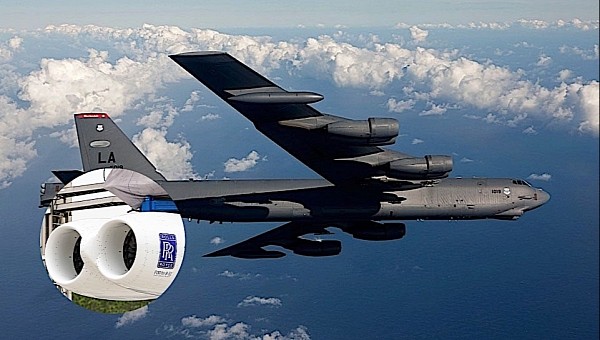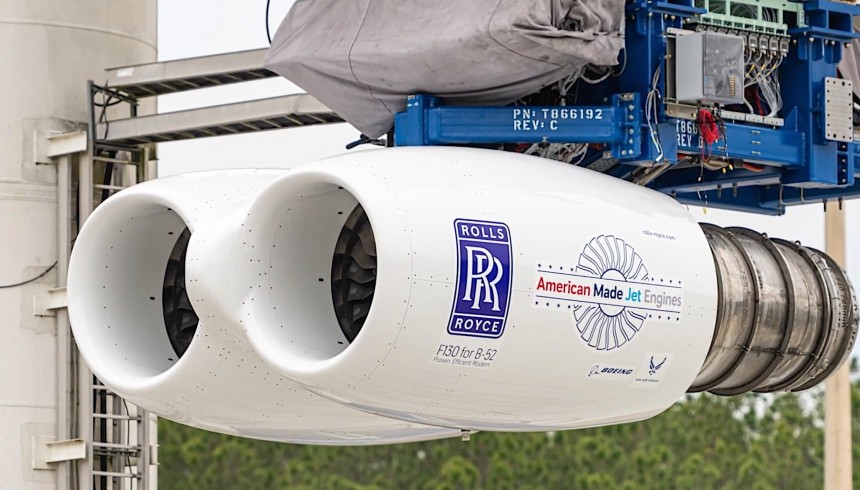By the time it retires in the 2050s, the B-52 Stratofortress will become the world’s oldest operational military airplane. How old, you ask? Well, given how the thing first flew in 1952, that would make it a full century of age!
Of course, the long-range strategic bomber we currently see in the skies above our heads is no longer the same as the one born after the Second World War, at least beyond its outer shell. That’s because, as it usually happens in military aviation, the plane has been modernized time and again to be kept relevant in our times.
The most recent modernization effort began not long ago, and it targets all the elements of the plane that need to be upgraded to keep it operational for the next three decades or so. That includes, for instance, the brakes that go on its wheels, the electronic warfare self-protection system, and, of course, the engines.
The Stratofortress has eight of them, nicely paired in four pods, two per wing. As they are today, they are of Pratt & Whitney make, capable of generating 17,000 lbs of thrust each. But they, too, are getting old, and back in late 2021, the U.S. Air Force decided a replacement is in order, if the B-52 is to stay in the sky for 30 more years. The military branch chose the Rolls-Royce F130 for the task.
This is a type of engine from the BR family of commercial powerplants, which are also seen on aircraft like the C-37 or E-11. They pack the same power per unit as the engines currently in use, but being brand new means they’ll help extend the life of the aging bomber.
This week Rolls-Royce began testing the F130 for its application on the B-52, with procedures underway at the NASA Stennis Space Center in Mississippi. The main goals of the tests are to see how they handle crosswind aerodynamic flow, but also to see how the digital controls system works.
Unlike some of the proposals put forward by competitors GE Aviation and Pratt & Whitney, which called for a reduction in the number of engines used by the plane, Rolls-Royce will stick to eight of them, in the same pod configuration as before, but in different positions. The tests now underway also mark the first time these units work in a dual-pod way.
The results of the procedures will be analyzed over the next few months, but a full test of an F130 pod isn’t expected earlier than 2025. After the final green light is given, the entire fleet of B-52s (75 of them) will get the new engines.
Given how not much will change in terms of power generated by the pieces of hardware, it is to be expected for the plane’s capabilities to remain largely the same. That means 8,800 miles (14,100 km) of range on a single full tank of fuel, and speeds that can reach 650 mph (1,046 kph).
The most recent modernization effort began not long ago, and it targets all the elements of the plane that need to be upgraded to keep it operational for the next three decades or so. That includes, for instance, the brakes that go on its wheels, the electronic warfare self-protection system, and, of course, the engines.
The Stratofortress has eight of them, nicely paired in four pods, two per wing. As they are today, they are of Pratt & Whitney make, capable of generating 17,000 lbs of thrust each. But they, too, are getting old, and back in late 2021, the U.S. Air Force decided a replacement is in order, if the B-52 is to stay in the sky for 30 more years. The military branch chose the Rolls-Royce F130 for the task.
This is a type of engine from the BR family of commercial powerplants, which are also seen on aircraft like the C-37 or E-11. They pack the same power per unit as the engines currently in use, but being brand new means they’ll help extend the life of the aging bomber.
Unlike some of the proposals put forward by competitors GE Aviation and Pratt & Whitney, which called for a reduction in the number of engines used by the plane, Rolls-Royce will stick to eight of them, in the same pod configuration as before, but in different positions. The tests now underway also mark the first time these units work in a dual-pod way.
The results of the procedures will be analyzed over the next few months, but a full test of an F130 pod isn’t expected earlier than 2025. After the final green light is given, the entire fleet of B-52s (75 of them) will get the new engines.
Given how not much will change in terms of power generated by the pieces of hardware, it is to be expected for the plane’s capabilities to remain largely the same. That means 8,800 miles (14,100 km) of range on a single full tank of fuel, and speeds that can reach 650 mph (1,046 kph).

















